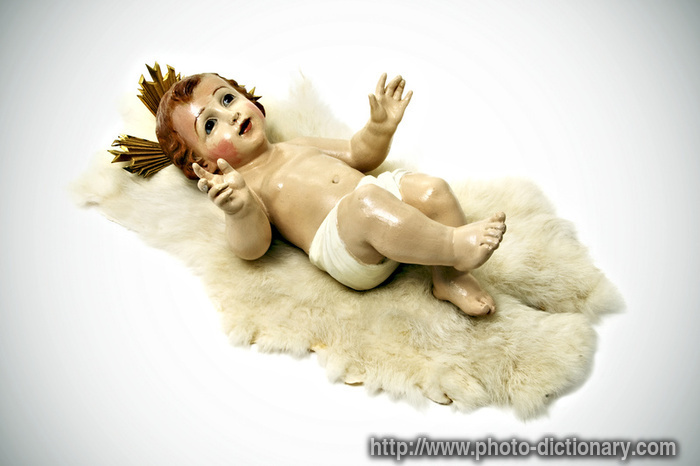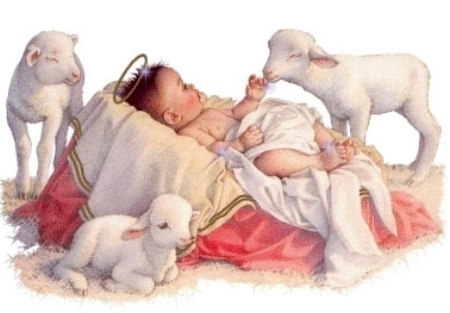Source(Google.com.pk)
Pic Of Baby Jesus Biography
"Jesus Christ" is Jesus of Nazareth, a rabbi and preacher whom is the central figure of Christianity.
What we know of him comes from the four Gospels of The New Testament: Matthew, Mark, Luke, and John. Biblical scholars agree that the earliest of the Gospels, Mark, was begun after 70 A.D., about 40 years after Jesus's death. Despite the tremendous fame The Gospels tell us that he earned, no contemporary accounts of Jesus exist. Philo (c25 B.C- 47 A.D), Pliny the Elder (23 B.C - 79 A.D), and Seneca (4 B.C.- 65 A.D) do not mention Jesus. Luke admits that he is merely an interpreter of the events he writes of and not an eyewitness (Luke 1:1-4). What non-Christian sources we have come from men who were born decades after his death (Josephus Flavius, Tacitus, Pliny the Younger). To further confuse matters, what we find in Matthew regarding Jesus's birth is not found in Luke, and vice versa.
Followers hold that: 1) Jesus fulfilled the Old Testament prophecy of The Christ or Messiah who would come from the tribe of Judah through King David; and 2) Jesus was born of his mother, Mary, not by her husband, Joseph, but by The Holy Spirit. Virgin birth is common in folklore, central to the myths of Ra, Krishna, Quetzalcoatl, Karna, Perseus, Mnos, Dionysus, and Hercules. Amenkept, Zoroaster, Siddhrtha Gautama, Alexander the Great, Constantine, and Nero also claimed to be of virgin birth as a way to claim superiority over all others. Yet, Jesus could not claim to be of David he had been fathered by The Holy Spirit. Futhermore, 2nd Kings, 2nd Chronicles, Ezra, and Nehemiah indicate that all of David's descendants were killed at the time of the return from the exile, thus, there were no princes left to continue the royal line.
Jesus was the eldest of four brothers and sisters (Mark 6:3; Matthew 12:46; Matthew 13:55-56), which, ironically, further undermines the claim of his virgin birth. Joseph taught him carpentry, by which Jesus earned his living until he began his ministry. Luke 2:42-50 states that when Jesus was 12, Mary and Joseph took him to Jerusalem for Passover. They were back in Nazareth when they realized that Jesus wasn't with their group. They returned to Jerusalem, and found him in the Temple with the with the Masters of the Law, Jewish priests trained to interpret the Scriptures. Based on what can be gleamed from The Gospels, Jesus may have been able to read. He was certainly acquainted with much of the Old Testament; his mode of argumentation resembled that of the contemporary rabbis. So, he could have been sophisticated enough at that age to hold his own in a discussion of the Scriptures with the Masters.
Jesus is next mentioned in The Gospels after he reaches adulthood. He performs many miracles, two of the most famous of which were feeding 5,000 men in the wilderness, and raising Lazarus of Bethany from the dead. Two essentials of his teachings came from John the Baptist: 1) repentance; and 2) the coming of the Kingdom of God. However, he differentiated from John in his: 1) comparative neglect of Mosaic Law; and 2) attitudes toward infractions of it. While he aimed to redeem those who had strayed morally, he forbade his disciples to seek out heathens and Samaritans; for that reason, he first refused to heal the Syrophenician woman's daughter (Mark 7:27). Unlike John, Jesus refused to fast, and allowed his followers to gather corn on the Sabbath.
As the Passover of the Year 29 approached, Jesus was determined to carry out the injunction which made it incumbent to eat the sacrificial lamb at Jerusalem. He was met in Jerusalem with a tremendous reception; his reputation as a miracle worker and healer had preceeded him. He soon became aware of the intention of the high priests to do him harm. While hiding in the Garden of Gethsemane, he was betrayed by one of his followers, Judas Iscariot. Why he was arrested is not clear: even if he claimed to be the Messiah, he would not have committed a crime according to Mosaic Law. What was clear is that he had become a threat to the high priests and the Romans alike, who had their hands full quelling a series of rebellions.
His trial before the Sanhedrin was for show (Matthew 26:59-68; Mark 14:63-64; Luke 22:63-71; John 18:12-24). John 11:47-52 makes clear that the Sanhedrin feared Jesus's growing popularity would be viewed by Rome as yet another threat to its authority. One charge made by the Sanhedrin was an alledged assertion by Jesus that he could overthrow the Temple, and replace it with one made without hands, an aspiritual kingdom. The Gospels repeatedly state that people fell before Jesus, and worshipped him as God; under Mosaic Law, that was not only blasphemy, but blasphemy against God. Jesus himself - for lack of a better term - flip-flopped on the issue of his divinty (Matthew 16:64; Mark 2:10, Mark 14:60-62; Luke 22:69). He was turned over to Pontius Pilate with the request that he be executed; fomenting tax resistance (Mark 2:14-15) - a capital offense - was added to the charges of blasphemy.
As it was Jewish tradition to release a prisoner at Passover, Pilate offered the crowd the choice between Jesus or Jesus Barabbas, a violent insurrectionist. Perhaps the crowd confused the two men as they shared the same first name, but the majority called for Barabbas to be freed.
Pic Of Baby Jesus

Pic Of Baby Jesus

Pic Of Baby Jesus
Pic Of Baby Jesus

Pic Of Baby Jesus

Pic Of Baby Jesus

Pic Of Baby Jesus

Pic Of Baby Jesus

Pic Of Baby Jesus

Pic Of Baby Jesus

No comments:
Post a Comment